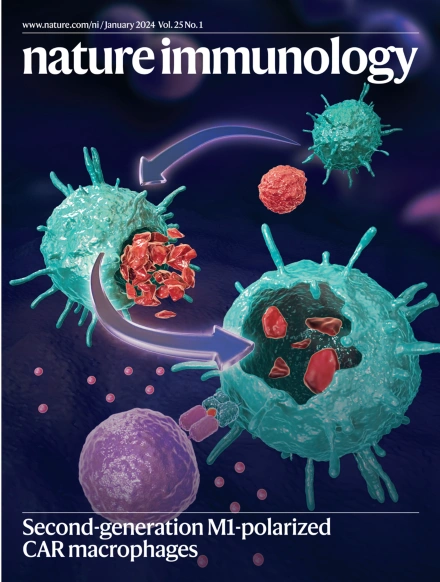Spatial proteomics of Alzheimer’s disease-specific human microglial states
IF 27.6
1区 医学
Q1 IMMUNOLOGY
引用次数: 0
Abstract
Microglia are implicated in aging, neurodegeneration and Alzheimer’s disease (AD). Low-plex protein imaging does not capture cellular states and interactions in the human brain, which differs from rodent models. Here we used multiplexed ion beam imaging to spatially map cellular states and niches in cognitively normal human brains, identifying a spectrum of proteomic microglial profiles. Defined by immune activation states that were skewed across brain regions and compartmentalized according to microenvironments, this spectrum enables the identification of proteomic trends across the microglia of ten cognitively normal individuals and orthogonally with single-nuclei epigenetic analysis, revealing associated molecular functions. Notably, AD tissues exhibit regulatory shifts in the immunologically active cells at the end of the proteomic spectrum, including enrichment of CD33 and CD44 and decreases in HLA-DR, P2RY12 and ApoE expression. These findings establish an in situ, single-cell spatial proteomic framework for AD-specific microglial states. In this Resource paper, the authors use MIBI spatial proteomics to map microglial cell states in brains from cognitively normal humans and those with Alzheimer’s disease.


阿尔茨海默病特异性人类小胶质细胞状态的空间蛋白质组学
小胶质细胞与衰老、神经变性和阿尔茨海默病(AD)有关。与啮齿类动物模型不同,低复合蛋白成像不能捕捉人类大脑中的细胞状态和相互作用。在这里,我们使用多路离子束成像在认知正常的人类大脑中空间绘制细胞状态和生态位,识别蛋白质组学小胶质谱。该光谱由免疫激活状态定义,该激活状态在大脑区域中倾斜,并根据微环境进行区隔,该光谱能够识别十个认知正常个体的小胶质细胞中的蛋白质组学趋势,并与单核表观遗传学分析正交,揭示相关的分子功能。值得注意的是,AD组织在蛋白质组学谱末端的免疫活性细胞中表现出调节性变化,包括CD33和CD44的富集以及HLA-DR、P2RY12和ApoE表达的降低。这些发现建立了ad特异性小胶质细胞状态的原位单细胞空间蛋白质组学框架。
本文章由计算机程序翻译,如有差异,请以英文原文为准。
求助全文
约1分钟内获得全文
求助全文
来源期刊

Nature Immunology
医学-免疫学
CiteScore
40.00
自引率
2.30%
发文量
248
审稿时长
4-8 weeks
期刊介绍:
Nature Immunology is a monthly journal that publishes the highest quality research in all areas of immunology. The editorial decisions are made by a team of full-time professional editors. The journal prioritizes work that provides translational and/or fundamental insight into the workings of the immune system. It covers a wide range of topics including innate immunity and inflammation, development, immune receptors, signaling and apoptosis, antigen presentation, gene regulation and recombination, cellular and systemic immunity, vaccines, immune tolerance, autoimmunity, tumor immunology, and microbial immunopathology. In addition to publishing significant original research, Nature Immunology also includes comments, News and Views, research highlights, matters arising from readers, and reviews of the literature. The journal serves as a major conduit of top-quality information for the immunology community.
 求助内容:
求助内容: 应助结果提醒方式:
应助结果提醒方式:


